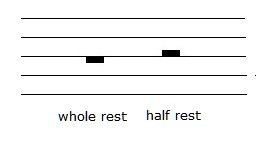Last week I wrote about the tabulature, semitones, whole tones and accidentals. In case you missed it here is the link: https://steemit.com/music/@hurtinalbertin/music-theory-lesson-2
This week I will introduce you to one more conept of semitones then I will show you notes and rests and their relative value.
These are simple concepts that you may already understand, but if you find that it is a lot to take in all at once, look it over carefully and don’t move on until you completely understand each concept fully. The objective here is to build a solid foundation of knowledge and build on it. If you forgot something that was covered go back and look it over again.
SEMITONES CONTINUED:
There is one more concept of semitones that I didn’t cover last time because the last lesson was becoming too long. It is also a very simple concept.
There are two types of semitones. These two types of semitones are chromatic and diatonic semitones.
A chromatic semitone is a semitone made up of two notes where both notes have the same letter name. Below are examples of chromatic semitones.

A diatonic semitone is a semitone made up of two notes where the notes have different letter names.

TIME VALUES:
Sounds in music have length or duration as well as pitch. Different notes are used to determine how long a note will last. Whole notes are used for the longest duration of a sound. This is a whole note:

If you want the sound to last half as long you can use a half note. A half note is a whole note with a stem:

If you want the sound to last half as long as a half note you can use a quarter note. A quarter note is a black note with a stem:

If you want the sound to last half as long as a quarter note you can use a eighth note. An eighth note is a quarter note with a flag:

Multiple eighth notes will sometimes be tied together with beams.

If you want the sound to last half as long as an eighth note you can use a sixteenth note. An sixteenth note is an quarter note with two flags:

Multiple sixteenth notes will also sometimes be tied together with two beams.

RESTS:
A rest is a symbol that indicates a period of silence. There is a rest that has a time value of each kind of note.





Be sure to remember that the whole and half rests sit on the center line of the staff. An easy way to remember whether the rest is whole or half is to think of it as the whole rest is heavy and hangs from the line and the half rest is light and floats above the line.

I will stop here and we will continue next week with lesson #4. Please comment or write questions below.